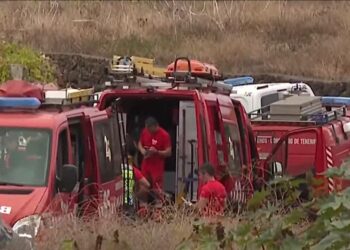retrieve the coffered ceiling It is one of the first actions that have been undertaken in the rehabilitation work of the masonic templeor, which celebrates a century of life since its completion in 1923. The wooden beams have been reinforced to support the weight of the rest of the floors on which a libraryin the first, and a research and study room, In the third. Together, it will become a museum of Freemasonry. This is how he explained it yesterday, maria nieves feblesthe architect responsible for the rehabilitation and construction management during the visit made by the mayor, José Manuel Bermúdez, together with the person in charge of Infrastructures, Javier Rivero, that of Culture, Santiago Díaz, and the councilor of the Centro-Ifara District, Alfonso Cabello.
As the mayor explained, the forecast is that the work will be finished by September of next year (it started in September of last year), if everything continues as it has been up to now, so that the long-awaited recovery is already on the equator. “The Masonic Temple is one of the examples of our commitment to the rehabilitation of heritage, a building that is one of the most important in the world of its kind, which makes it an exclusive symbol of Santa Cruz,” said the councilor, who He recalled that it is a work with a budget of three million euros.
Bermúdez advanced that one of the objectives of this year will be to sign an agreement with the State to ensure that the documents that remain from the Añaza Lodge, promoter of the construction of the Temple, which are kept in the Salamanca archive, come back to Santa Cruz. “The objective of the reform is to convert the Masonic Temple into a center for the study of Freemasonry in general, and of the Lodge of Añaza in particular, for this reason we do not renounce having the archives of the lodge in the Temple.” Bermúdez recalled that an agreement has already been signed with the Grand Lodge of Spain, “to be able to open the Temple as a museum of Freemasonry,” he insisted.

The mayor of Works, for his part, pointed out that “at the moment, together with the Masonic Temple, there are two other heritage works underway that total 15 million euros. It is about Viera y Clavijo and the old Recova”.
Febles, as an architect, admitted that one of the most attractive parts of this project has been the prior documentation to be able to correctly interpret all the symbols that surround the construction and that will be respected in all the rehabilitation work.
“The intervention goes beyond any other work, because here everything has a very specific use and you have to understand it to reproduce it correctly. He gave as an example the five steps that give access to the building, the columns that resemble those of the Temple of King Solomon, or the same ones reproduced in wood on both sides of the door, “everything has a meaning and a symbology that must be understood.” respect”.
It is expected to be finished in September 2024
The construction manager pointed out that the most complicated part of the rehabilitation is the treatment of the original wood, praising the specialists that the company awarded the works, Víctor Rodríguez, has. The pavement has been another of the most complicated points, since “they were in very poor condition and will be replaced in their entirety, yes, we will maintain the original drawing, but with new material”. The checkerboard-shaped floor is one of the most recognizable features of the Masonic Temple.
María Nieves Febles recognized that the building is quite deteriorated, not only because of the uses it was put to after the Civil War, but also because of the poor waterproofing of the roof, which caused leaks and affected the roof slabs. As for the reflection chamber, which is located under the building, in a cave excavated in the rock, one of the most unique parts of the Temple, she advanced that it will be left as is, only with some security improvements. She also pointed out that the so-called Meeting Room will restore the original celestial vault.
polychrome
One of the jobs that requires the most specialization in this rehabilitation are the polychromies that decorated the Temple and that, along with the floors, are also the most characteristic features of the building. A team of restorers from the University of La Laguna, led by Laura Sierra, is in charge of recovering these original colors, in the cases in which it is possible, since there are parts that, unfortunately, have disappeared.

Juan Antonio Muñoz is one of the restorers and explained: “We are recovering the original polychrome that is under the layer of plastic paint with which they covered almost the entire Temple, and in the area below it is being recovered, in the the pilasters, the original polychromy, under that blue paint that can be seen. Also, in the plinth areas, the original walls are being protected, because the wall presents losses of support, there are even patches in which cement was chipped and added, and then the original areas must be protected, for later consolidation through of the wall, and also to protect the painting of the work itself”.
Muñoz also clarified that there are many losses because walls have been chipped, covered with cement and painted over the original polychrome. “We did the solubility tests to get to the original painting, and in that part we discovered a cement that has caused the entire original part to be lost. It cannot be recovered because it does not exist, ”he pointed out.
“Even so”, he explained, “an intervention is going to be made in which the spatial vision of what the room used to be reproduced, with restoration techniques, both here and in the Agape Room. In this last room, the border is being intervened, which has been able to be recovered in a high percentage”, Muñoz remarked.
















